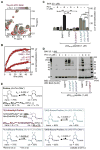Pin1-Induced Proline Isomerization in Cytosolic p53 Mediates BAX Activation and Apoptosis
- PMID: 26236013
- PMCID: PMC4546541
- DOI: 10.1016/j.molcel.2015.06.029
Pin1-Induced Proline Isomerization in Cytosolic p53 Mediates BAX Activation and Apoptosis
Abstract
The cytosolic fraction of the tumor suppressor p53 activates the apoptotic effector protein BAX to trigger apoptosis. Here we report that p53 activates BAX through a mechanism different from that associated with activation by BH3 only proteins (BIM and BID). We observed that cis-trans isomerization of proline 47 (Pro47) within p53, an inherently rare molecular event, was required for BAX activation. The prolyl isomerase Pin1 enhanced p53-dependent BAX activation by catalyzing cis-trans interconversion of p53 Pro47. Our results reveal a signaling mechanism whereby proline cis-trans isomerization in one protein triggers conformational and functional changes in a downstream signaling partner. Activation of BAX through the concerted action of cytosolic p53 and Pin1 may integrate cell stress signals to induce a direct apoptotic response.
Copyright © 2015 Elsevier Inc. All rights reserved.
Figures




Similar articles
-
Mutations in proline 82 of p53 impair its activation by Pin1 and Chk2 in response to DNA damage.Mol Cell Biol. 2005 Jul;25(13):5380-8. doi: 10.1128/MCB.25.13.5380-5388.2005. Mol Cell Biol. 2005. PMID: 15964795 Free PMC article.
-
A tethering mechanism underlies Pin1-catalyzed proline cis-trans isomerization at a noncanonical site.Proc Natl Acad Sci U S A. 2025 May 27;122(21):e2414606122. doi: 10.1073/pnas.2414606122. Epub 2025 May 19. Proc Natl Acad Sci U S A. 2025. PMID: 40388619
-
Regulation of the transcriptional activity of c-Fos by ERK. A novel role for the prolyl isomerase PIN1.J Biol Chem. 2005 Oct 21;280(42):35081-4. doi: 10.1074/jbc.C500353200. Epub 2005 Aug 25. J Biol Chem. 2005. PMID: 16123044
-
Interaction of p53 with prolyl isomerases: Healthy and unhealthy relationships.Biochim Biophys Acta. 2015 Oct;1850(10):2048-60. doi: 10.1016/j.bbagen.2015.01.013. Epub 2015 Jan 29. Biochim Biophys Acta. 2015. PMID: 25641576 Review.
-
KeePin' the p53 family in good shape.Cell Cycle. 2004 Jul;3(7):905-11. Epub 2004 Jul 2. Cell Cycle. 2004. PMID: 15254434 Review.
Cited by
-
An anterograde pathway for sensory axon degeneration gated by a cytoplasmic action of the transcriptional regulator P53.Dev Cell. 2021 Apr 5;56(7):976-984.e3. doi: 10.1016/j.devcel.2021.03.011. Dev Cell. 2021. PMID: 33823136 Free PMC article.
-
Aristolochic acid I induces impairment in spermatogonial stem cell in rodents.Toxicol Res (Camb). 2021 Apr 26;10(3):436-445. doi: 10.1093/toxres/tfab038. eCollection 2021 May. Toxicol Res (Camb). 2021. PMID: 34141157 Free PMC article.
-
[Nucleus translocation of membrane/cytoplasm proteins in tumor cells].Zhejiang Da Xue Xue Bao Yi Xue Ban. 2019 May 25;48(3):318-325. doi: 10.3785/j.issn.1008-9292.2019.06.13. Zhejiang Da Xue Xue Bao Yi Xue Ban. 2019. PMID: 31496165 Free PMC article. Chinese.
-
Role of p53 and transcription-independent p53-induced apoptosis in shear-stimulated megakaryocytic maturation, particle generation, and platelet biogenesis.PLoS One. 2018 Sep 19;13(9):e0203991. doi: 10.1371/journal.pone.0203991. eCollection 2018. PLoS One. 2018. PMID: 30231080 Free PMC article.
-
Targeting Pin1 for Modulation of Cell Motility and Cancer Therapy.Biomedicines. 2021 Mar 31;9(4):359. doi: 10.3390/biomedicines9040359. Biomedicines. 2021. PMID: 33807199 Free PMC article. Review.
References
-
- An SSA, Lester CC, Peng JL, Li YJ, Rothwarf DM, Welker E, Thannhauser TW, Zhang LS, Tam JP, Scheraga HA. Retention of the cis proline conformation in tripeptide fragments of bovine pancreatic ribonuclease A containing a non-natural proline analogue, 5,5-dimethylproline. J Am Chem Soc. 1999;121:11558–11566.
-
- Chipuk JE, Bouchier-Hayes L, Kuwana T, Newmeyer DD, Green DR. PUMA couples the nuclear and cytoplasmic proapoptotic function of p53. Science. 2005;309:1732–1735. - PubMed
-
- Chipuk JE, Kuwana T, Bouchier-Hayes L, Droin NM, Newmeyer DD, Schuler M, Green DR. Direct activation of Bax by p53 mediates mitochondrial membrane permeabilization and apoptosis. Science. 2004;303:1010–1014. - PubMed
Publication types
MeSH terms
Substances
Grants and funding
- R01 GM083159/GM/NIGMS NIH HHS/United States
- R25 CA023944/CA/NCI NIH HHS/United States
- R01CA082491/CA/NCI NIH HHS/United States
- P30CA21765/CA/NCI NIH HHS/United States
- R01 CA082491/CA/NCI NIH HHS/United States
- R01CA157740/CA/NCI NIH HHS/United States
- R01 CA157740/CA/NCI NIH HHS/United States
- 1R01GM083159/GM/NIGMS NIH HHS/United States
- R01 GM052735/GM/NIGMS NIH HHS/United States
- R01 GM096208/GM/NIGMS NIH HHS/United States
- R01GM52735/GM/NIGMS NIH HHS/United States
- R01GM96208/GM/NIGMS NIH HHS/United States
- P30 CA021765/CA/NCI NIH HHS/United States
LinkOut - more resources
Full Text Sources
Other Literature Sources
Molecular Biology Databases
Research Materials
Miscellaneous

